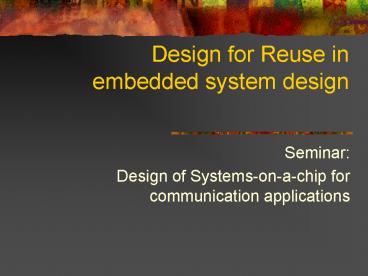Design for Reuse in embedded system design - PowerPoint PPT Presentation
1 / 30
Title:
Design for Reuse in embedded system design
Description:
Design of Systems-on-a-chip for communication applications ... Verilog HDL coding. Based on IEEE 1364.1 Verilog subset. Documentation ... – PowerPoint PPT presentation
Number of Views:110
Avg rating:3.0/5.0
Title: Design for Reuse in embedded system design
1
Design for Reuse in embedded system design
- Seminar
- Design of Systems-on-a-chip for communication
applications
2
Agenda
- Introduction
- Reusability and Design
- Standards and Tools
- Research Topics
- Conclusions
3
1.Introduction
- What is an embedded system?
- A special-purpose computer built into and
integral to a device.
4
1.Introduction
- Systems-on-a-chip
5
1.Introduction
- Potential vs. Productivity
6
1.Introduction
- Systems-on-a-chip
- Nearly boundless transistor capacity on ICs
- Conventional design techniques are not adequate
- New design challenges emerge
- Complex designs
- Increase level of abstraction
- Time to market
7
Agenda
- Introduction
- Reusability and Design
- Standards and Tools
- Research Topics
- Conclusions
8
2. Design and Reusability
- Higher level of Abstraction
- Reach more complexity
- Dont think about implementation details
- Example
- Software
- RISC vs. CISC
- Reliable compilers
- Hardware
- Synthesis
9
2. Design and Reusability
- What is the difference in SoC Design?
Block Selection/ design
Time to market
10
2. Design and Reusability
- If a previous designed-blocks library is
available
11
2. Design and Reusability
- A design must be first usable.
- Design for use requires
- Good documentation
- Good code
- Through commenting
- Well-designed verification environments and
suites - Robust scripts
12
2. Design and Reusability
- Design Reuse
- The ability to retarget previously designed
building blocks or cores on a chip for a new
design in order to reduce time to market
13
2. Design and Reusability
- Design for Reuse requires
- Designs oriented to solve general problems
- Flexibility
- Use in multiple technologies
- Simulation with different simulators
- Independent and rigorous verification
- Full documentation
14
2. Design and Reusability
- Basic units
- IP Blocks (also called cores, virtual components,
macros) - Pre-designed, pre-verified complex functional
blocks. - Hard cores
- (black boxes, layout level, certain silicon
process) - Soft cores
- (white boxes, RTL level)
- Firm cores
- (grey boxes, configurable i/o,)
15
2. Design and Reusability
- The Development Tree
Hardcores
Implementation
Layout (aspect ratio, cell positions)
Description (Diagram, HDL)
Specification
16
2. Design and Reusability
- Reusability is not a new method
- J. S. Bachs composition method (XVIII century)
- Not based on single notes
- Figures
- Corta
- Groppo
- Tirata
- Pre-designed structures
- High complex compositions
- Problem
- How to harmonise together the figures?
17
2. Design and Reusability
- Fundamental Problems for Reuse
- Blocks not in appropriate representation
- Incomplete design information
- Disperse Designs
- Unavailable tools
- Simulation not viable
- In other words
- Designing systems without thinking on reusability
- Possible Solution
- Observe Standards and use adequate tools
18
Agenda
- Introduction
- Reusability and Design
- Standards and Tools
- Research Topics
- Conclusions
19
3. Standards and Tools
- Virtual Socket Interface Alliance (VSIA)
- Facilitates adoption of design reuse
- Sets Standards for tool Interfaces and design
practices - Architecture document
- User guide
- System and logic design
- Test requirements
- Physical implementation
20
3. Standards and Tools
- Motorolas Semiconductor reuse Standard
- http//e-www.motorola.com/technology/srs/
- IP/VC block deliverables
- Data to develope and formats
- IP Interface
- Rapid SoC integration
- Verilog HDL coding
- Based on IEEE 1364.1 Verilog subset
- Documentation
- IP creation, use, integration and Tests
21
3. Standards and Tools
- OpenMORE
- Open Measure of Reuse Excellence
- Free Web-Based measurement tool
- Developed by Synopsys and Mentor Graphics
- Based on the Reuse Methodology Manual (RMM)
- Donation to VSIA on June 18th 2001
- http//www.openmore.com/openmore/download.cfm
22
3. Standards and Tools
- OpenMORE
- What is required to produce one core?
- How difficult is to integrate certain core?
- Used for
- Developing reuse infrastructure
- Key and deliverable specification
- Evaluate intellectual property using Guidelines
- 150 for softcores
- 90 for hardcores
23
3. Standards and Tools
- OpenMORE
- Grading process
- Maximum points
- 730 for softcores
- 530 for hardcores
- Guidelines Categories
- Macro Design
- Verification
- Deliverables
- Ratings in Synopsys Catalyst catalogues
24
3. Standards and Tools
- AMBA Bus
- Open Standard on Chip specification
- Reusable design methodology
- Common backbone for SoC modules
25
3. Standards and Tools
- CoreConnect Bus Architecture
- Foundation of IBM Blue Logic
- 32- and 64- bit architecture versions
- Separate read-write data buses.
26
Agenda
- Introduction
- Reusability and Design
- Standards and Tools
- Research Topics
- Conclusions
27
5. Research topics
- IP component description for multi-media
applications
28
5. Research topics
- Behavioural hardware reuse
- Using C for SoC design
- Usually done at structural level
29
Agenda
- Introduction
- Reusability and Design
- Standards and Tools
- Research Topics
- Conclusions
30
6. Conclusions
- Reuse permits complex designs
- Reuse attitude is required
- Design thinking on reusability
- IP blocks must be easy to use
- Well designed re-usable IP components enable
successful SoC integration































